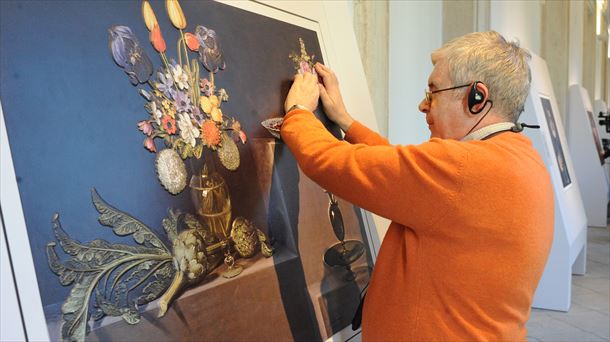How to present works of art to blind people? What means to use to guarantee a quality experience? What needs and concerns need to be met? That’s where museums, galleries and artists start to make art as accessible and inclusive as possible.
The Guggenheim Museum Bilbao has recently presented a scale reproduction of the work “Tulips” by sculptor Jeff Koons. A replica that comes to expand the museum’s collection, in which those of “Puppy”, “Mama”, “The Big Tree and the Eye” and that of the Guggenheim building itself stand out.
The museum decided from the outset that the models would be one of the “main lines” to bring art closer to blind people. Rogelio Díez, deputy director of Maintenance and Installations at the Guggenheim Museum, explains that he contacted ONCE “practically since the museum opened”, in order, together with his advice, to achieve universal accessibility to all types of public.
Ana Dávila, head of the Department of Social Services for Members of ONCE in the Basque Country, clarifies that the “shared goal” with the entities that it advises is to make every visit accessible to the group of blind people. “It is important to touch, but we must also know that tulips have different colors, which are not perceived by touch. Must complement the work with a guide”, he adds. ONCE has transcribed the texts into braille, and will soon organize visits to the museum.
Listen carefully
In addition to the text, Dávila stresses the importance of not only being able to play the work, but also being able to understand it as well as possible; for a blind person it is important that the information comes from different senses: “We try to have audio guides with a specific channel, which is not usual”. This implies that in addition to the description of what is exposed there are spatial references. “It is complementary information. I don’t know if the color of the tulips, the order of the petals and colors will be discussed.”
Díez has expressed the intention to continue working on the audio descriptions of the works. Previously, they produced the audios of the exterior works of the museum. “We want to take them back and enrich the audio descriptions; they are a great tool“.

A visitor touching a relief painting. Photo: ONCE
In an attempt to demonstrate the need for an audio channel, Dávila pulls out a box to play that he had saved. Wearing a mask, he begins the experiment. Total darkness; nothing is seen. A rectangular frame with a canvas-textured background. Raised lines drawn from the lower left to the upper right. A circular silhouette is perceived in the latter; A little further down, two circular shapes with a dot in the middle. Two textures, one smooth, the other velvety, surround the figure.
Could the background be a sky? The circle at the end, the moon? Dávila begins to describe the setting: “The canvas presents the portrait of a completely naked young woman facing the viewer. She is lying down.” “The Naked Maja” by Goya. “Touch adds up, but it’s important to have access to complementary information,” he adds.
trustworthy touch
The collection of models is part of the works that can be touched in the tactile guides offered by the museum. The recent reproduction of “Tulipanes” responds to the impossibility of being able to play the original work. “‘Tulipanes’ is a work that cannot be touched nor in tactile visits. It is of a polished steel that leaves traces; you would have to touch her with gloves, but she would lose all the grace, right? “, comments Díez.
Just like the shape, the material has been respected in the last replica as in the previous ones. The flower skin of “Puppy”; the bronze, marble and stainless steel of “Mama”; the titanium of the museum; the stainless steel of “The Big Tree and the Eye”. This time, from metallic powder, the petals of the tulips have been printed in 3D and finished with a jewelery polish, so that they would be “the most faithful to the true”.
It supposes a work that has as objective “to educate and to make enjoy”. “Mechanisms must be put in place for this; each visitor encounters a different reality, and we have to be able to ensure that at least part of it reaches everyone,” insists Díez. Dávila himself condenses the objective of the organization’s work: “Ultimately, the inclution“.
Source: Eitb
Mario Twitchell is an accomplished author and journalist, known for his insightful and thought-provoking writing on a wide range of topics including general and opinion. He currently works as a writer at 247 news agency, where he has established himself as a respected voice in the industry.











